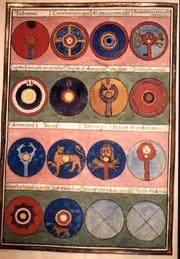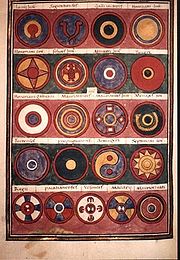
Notitia Dignitatum
Encyclopedia

Ancient Rome
Ancient Rome was a thriving civilization that grew on the Italian Peninsula as early as the 8th century BC. Located along the Mediterranean Sea and centered on the city of Rome, it expanded to one of the largest empires in the ancient world....
imperial chanceries. One of the very few surviving documents of Roman government, it details the administrative organisation of the eastern and western empire
Roman Empire
The Roman Empire was the post-Republican period of the ancient Roman civilization, characterised by an autocratic form of government and large territorial holdings in Europe and around the Mediterranean....
s, listing several thousand offices from the imperial court down to the provincial level. It is usually considered to be up to date for the Western empire
Western Roman Empire
The Western Roman Empire was the western half of the Roman Empire after its division by Diocletian in 285; the other half of the Roman Empire was the Eastern Roman Empire, commonly referred to today as the Byzantine Empire....
in the 420s, and for the Eastern empire in 400s. However, no absolute date can be given, and there are omissions and problems.
There are several extant fifteenth and sixteenth-century copies (plus a color-illuminated 1542 version). All the known and extant copies of this late Roman document are derived, either directly or indirectly, from a codex
Codex
A codex is a book in the format used for modern books, with multiple quires or gatherings typically bound together and given a cover.Developed by the Romans from wooden writing tablets, its gradual replacement...
(Codex Spirensis) that is known to have existed in the library of the cathedral chapter at Speyer
Speyer
Speyer is a city of Rhineland-Palatinate, Germany with approximately 50,000 inhabitants. Located beside the river Rhine, Speyer is 25 km south of Ludwigshafen and Mannheim. Founded by the Romans, it is one of Germany's oldest cities...
in 1542 but which was lost before 1672 and cannot now be located. That book contained a collection of documents (of which the Notitia was the last and largest document, occupying 164 pages) that brought together several previous documents of which one was of the 9th century. The heraldry
Heraldry
Heraldry is the profession, study, or art of creating, granting, and blazoning arms and ruling on questions of rank or protocol, as exercised by an officer of arms. Heraldry comes from Anglo-Norman herald, from the Germanic compound harja-waldaz, "army commander"...
in illuminated manuscripts of Notitiae is thought to copy or imitate no other examples than those from the lost Codex Spirensis. The most important copy of the Codex is that made for Pietro Donato
Pietro Donato
Pietro Donato was a Renaissance humanist and the Bishop of Padua . He was a noted bibliophile, epigraphist, collector, and patron of art....
(1436), illuminated by Peronet Lamy
Peronet Lamy
Peronet Lamy , called Perenet lenlumineur , was a Gothic painter and manuscript illuminator who spent his career in the employ of the House of Savoy....
.
Contents
For each half of the empire, the Notitia enumerates all major 'dignities' (i.e. offices) in its gift, often with their location and even their exact officiumOfficium
Officium is a Latin word with various meanings in Ancient Rome, including "service", " duty", "courtesy", "ceremony" and the like...
(staff, enumerated except for the most junior). These are organised by:
- Court officials (including the most senior dignitaries such as praetorian prefectPraetorian prefectPraetorian prefect was the title of a high office in the Roman Empire. Originating as the commander of the Praetorian Guard, the office gradually acquired extensive legal and administrative functions, with its holders becoming the Emperor's chief aides...
s).
- VicarsVicariusVicarius is a Latin word, meaning substitute or deputy. It is the root and origin of the English word "vicar" and cognate to the Persian word most familiar in the variant vizier....
and provincial governorsRoman provinceIn Ancient Rome, a province was the basic, and, until the Tetrarchy , largest territorial and administrative unit of the empire's territorial possessions outside of Italy...
, arranged by praetorian prefecturePraetorian prefectureThe praetorian prefecture was the largest administrative division of the late Roman Empire, above the mid-level dioceses and the low-level provinces. Praetorian prefectures originated in the reign of Constantine I The praetorian prefecture was the largest administrative division of the late Roman...
and dioceseRoman dioceseA Roman or civil diocese was one of the administrative divisions of the later Roman Empire, starting with the Tetrarchy. It formed the intermediate level of government, grouping several provinces and being in turn subordinated to a praetorian prefecture....
.
- Military commanders (magistri militumMagister militumMagister militum was a top-level military command used in the later Roman Empire, dating from the reign of Constantine. Used alone, the term referred to the senior military officer of the Empire...
, comites rei militarisComesComes , plural comites , is the Latin word for companion, either individually or as a member of a collective known as comitatus, especially the suite of a magnate, in some cases large and/or formal enough to have a specific name, such as a cohors amicorum. The word comes derives from com- "with" +...
and ducesDuxDux is Latin for leader and later for Duke and its variant forms ....
), showing the full titles and stations of their regiments.
The most recent editor of Notitia Dignitatum is Robert Ireland, in British Archaeological Reports, International Series 63.2.
Interpretation

- The Notitia depicts the Roman armyRoman armyThe Roman army is the generic term for the terrestrial armed forces deployed by the kingdom of Rome , the Roman Republic , the Roman Empire and its successor, the Byzantine empire...
at the end of the 4th century. Therefore its development over the 4th century from the PrincipatePrincipateThe Principate is the first period of the Roman Empire, extending from the beginning of the reign of Caesar Augustus to the Crisis of the Third Century, after which it was replaced with the Dominate. The Principate is characterized by a concerted effort on the part of the Emperors to preserve the...
structure is largely conjectural, owing to the lack of other evidence. - It was compiled at two different times. The Eastern section apparently dates from c395 AD; the Western from considerably later, c420. Furthermore, each section is probably not a contemporaneous "snapshot", but relies on data stretching back as far as twenty years. The Eastern section may contain data from as early as 379, the start of the rule of Theodosius ITheodosius ITheodosius I , also known as Theodosius the Great, was Roman Emperor from 379 to 395. Theodosius was the last emperor to rule over both the eastern and the western halves of the Roman Empire. During his reign, the Goths secured control of Illyricum after the Gothic War, establishing their homeland...
. The Western section contains data from as early as c400: for example, it shows units deployed in Britain, which must date from before 410, when Roman troops were evacuated from the island. In consequence, there is substantial duplication, with the same unit often listed under different commands. It is impossible to ascertain whether these were detachments of the same unit in different places at the same time, or the same whole unit at different times. Also, it is likely that some units only existed on paper or contained just a skeleton personnel. - The Notitia has many sections missing and lacunae (gaps) within sections. This is doubtless due to accumulated text losses and copying errors as it was repeatedly copied over the centuries: the earliest manuscript we possess today dates from the 15th century. The Notitia cannot therefore provide a comprehensive listing of all units in existence.
- The Notitia does not contain any personnel figures. Therefore, the size of individual units, and of the various commands, cannot be ascertained, as we have little other evidence of unit sizes at this time. In turn, this makes it impossible to assess accurately the overall size of the army. Depending on the strength of units, the late 4th century army may, at one extreme, have equalled the size of the 2nd century force (i.e. over 400,000 men); at the other extreme, it may have been far smaller. For example, the forces deployed in Britain c400 may have been just 18,000 against c55,000 in the 2nd century.
Depictions
The Notitia contains the earliest known depictions of the diagram which later came to be known as yin and yang symbol. The infantry units armigeri defensores seniores ("shield-bearers") and Mauri Osismiaci had a shield design which corresponds to the dynamic, clockwise version of the symbol. The emblem of the Thebaei, another Western Roman infantry regiment, featured a pattern of concentric circles comparable to its static version. The Roman patterns predate the earliest TaoistTaoism
Taoism refers to a philosophical or religious tradition in which the basic concept is to establish harmony with the Tao , which is the mechanism of everything that exists...
versions by almost seven hundred years.
Sources and references
- Westermann Großer Atlas zur Weltgeschichte contains many precise maps
- Pauly-WissowaPauly-WissowaThe Realencyclopädie der Classischen Altertumswissenschaft, commonly called the Pauly–Wissowa or simply RE, is a German encyclopedia of classical scholarship. With its supplements it comprises over eighty volumes....
(German-language encyclopaedia on all classical Antiquity) provides articles and further bibliography on almost every term or name one might wish to know more about - Notitia dignitatum: accedunt Notitia urbis ConstantinopolitanaeNotitia urbis ConstantinopolitanaeThe Notitia Urbis Constantinopolitanae is an ancient "regionary", i.e., a list of monuments, public buildings and civil officials in Constantinople during the mid-5th century , during the reign of the emperor Theodosius II...
et LaterculiLaterculusIn late antiquity or the early medieval period, a laterculus is an inscribed tile, stone or terracotta tablet used for publishing certain kinds of information in list or calendar form. The term thus came to be used for the content represented by such an inscription, most often a list, register, or...
provinciarum, edidit Otto SeeckOtto SeeckOtto Seeck was a German classical historian who is perhaps best known for his work on the decline of the ancient world. He was born in Riga....
, Berolini: Weidmann, 1876. - A.H.M. Jones, The Later Roman Empire, 284-602. A Social, Economic and Administrative Survey, The Johns Hopkins University Press, 1986, ISBN 0-8018-3285-3
External links
- Bayerische Staatsbibliothek: Notitia Dignitatum Clm 10291 − full online scan of the 1542 manuscript with its modernised illustrations
- Related Latin texts, translations and commentaries (including maps and concordances) are listed at the Cnd website
- Medieval Sourcebook English translation by William Fairley
- Notitia Dignitatum, with pictures, from bibliotheca Augustana
- "Notitia Dignitatum", Otto Seeck, ed. 1876
- Dr Ingo Maier on Notitia Dignitatum
- Notitia Dignitatum at IntraText

